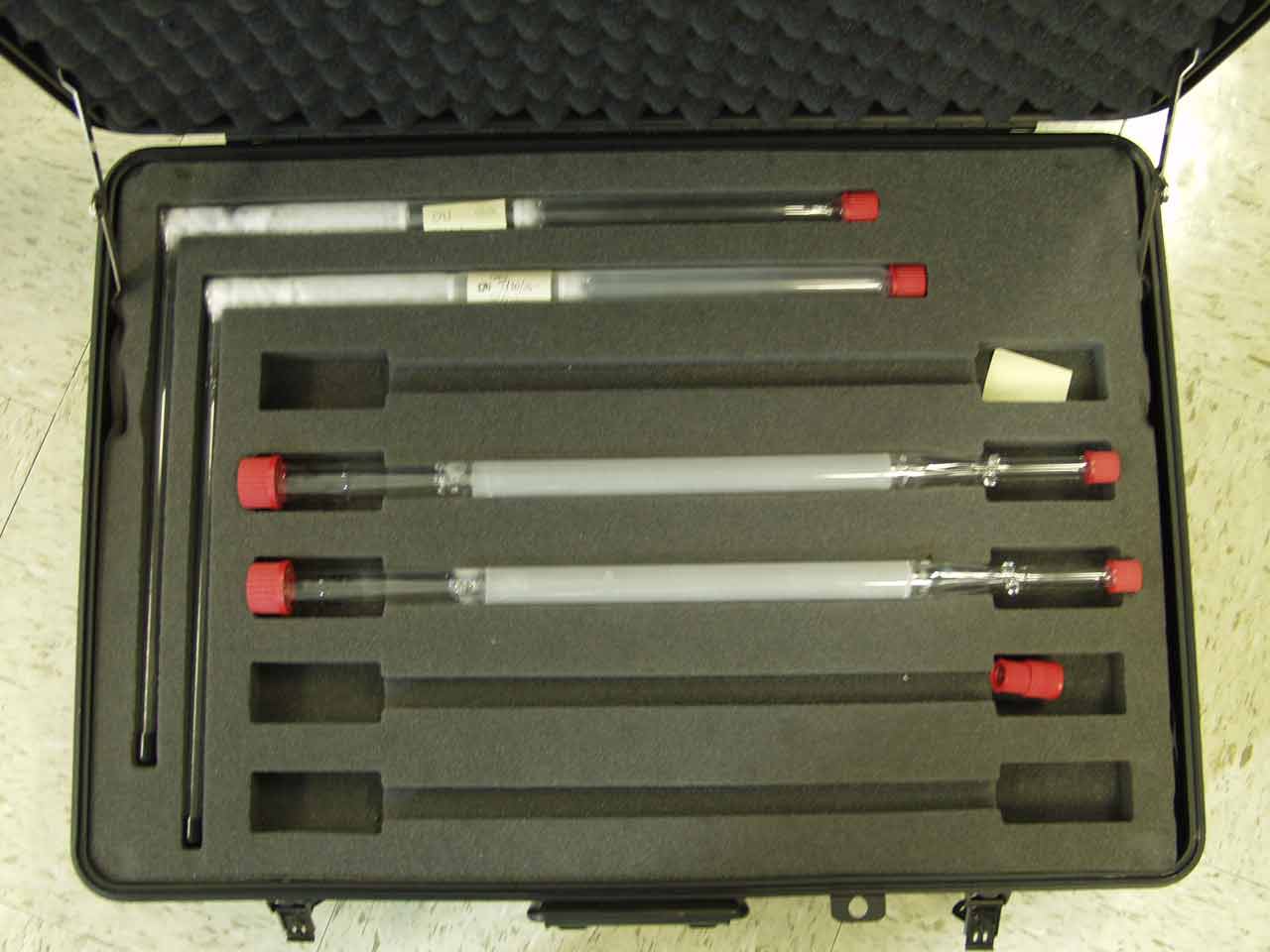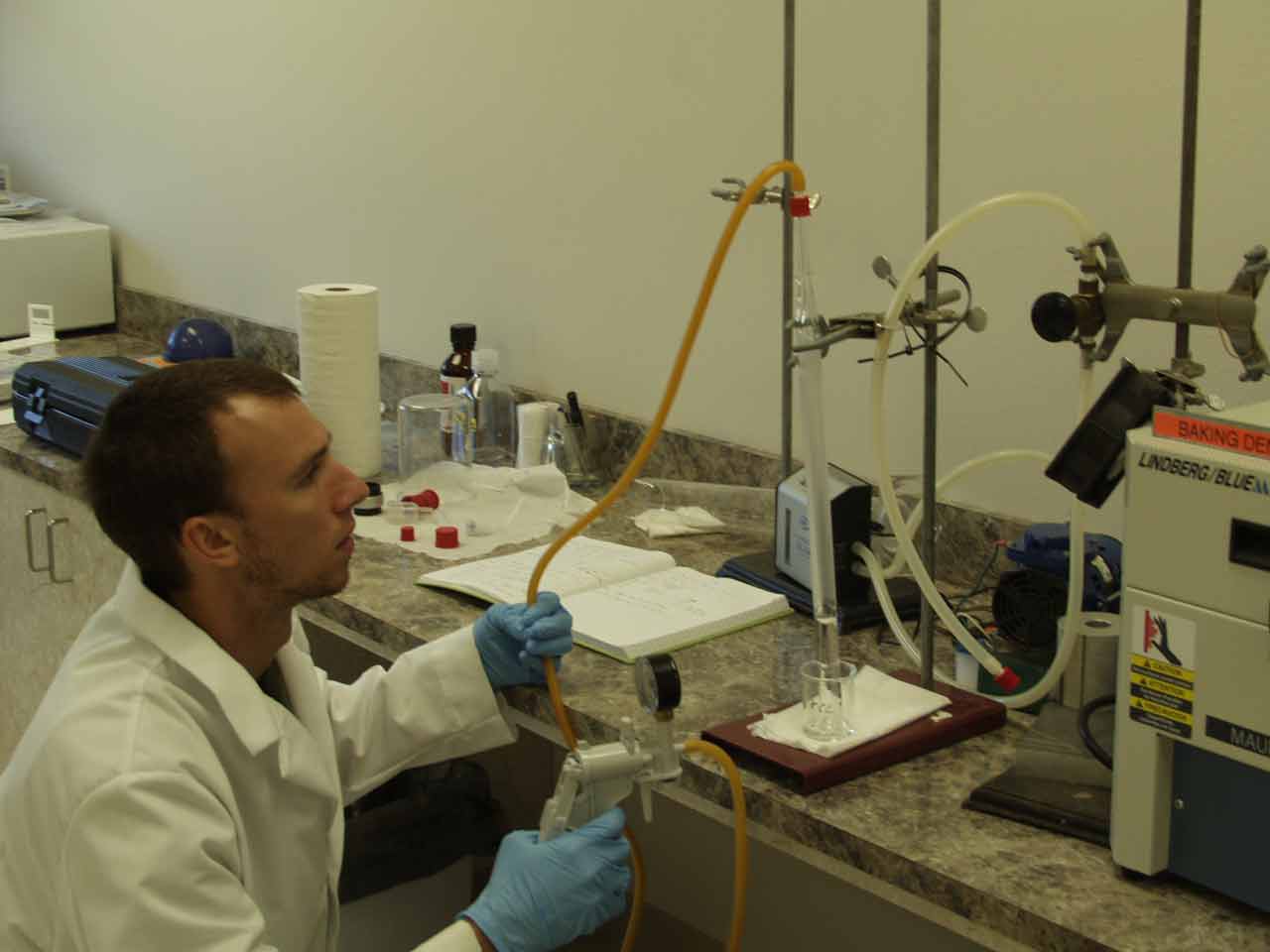Difference between revisions of "Denuder"
Shawndouglas (talk | contribs) (Created as needed.) |
Shawndouglas (talk | contribs) (Added images.) |
||
| Line 1: | Line 1: | ||
A '''denuder''' is a cylindrical or annular conduit or tube internally coated with a reagent that selectively reacts with a stable flow of gas drawn through the conduit. The gas molecules diffuse to the walls while the [[analyte]] contained in the gas is transmitted outwards via laminar flow, collected, and analyzed. <ref name="SampPrep">{{cite book |url=http://books.google.com/books?id=N3Es-WvRoZcC |chapter=Chapter 5: Automated diffusion-based collection and measurement of atmospheric trace gases |title=Sampling and Sample Preparation for Field and Laboratory: Fundamentals and New Directions in Sample Preparation |volume=37 |author=Dasgupta, Purnendu K.; Pawliszyn, Janusz (ed.) |publisher=Elsevier |year=2002 |pages=97–160 |isbn=0444505105}}</ref><ref name="AnChemAero">{{cite book |url=http://books.google.com/books?id=EK7cz4IXcB0C |chapter=Chapter 4: Filtration and Denuder Sampling Techniques |title=Analytical Chemistry of Aerosols |author=Kito, A-M. N.; Colbeck, I.; Spurny, Kvetoslav R. (ed.) |publisher=CRC Press |year=1999 |pages=103–132 |isbn=156670040X}}</ref> Effectiveness of the system depends primarily "on a complete discrimination between the gas species and particulate matter."<ref name="AnChemAero" /> | [[File:Denuders.jpg|thumb|180px|Denuders, as used in atmospheric research by the NOAA Earth System Research Laboratory, Global Monitoring Division]]A '''denuder''' is a cylindrical or annular conduit or tube internally coated with a reagent that selectively reacts with a stable flow of gas drawn through the conduit. The gas molecules diffuse to the walls while the [[analyte]] contained in the gas is transmitted outwards via laminar flow, collected, and analyzed. <ref name="SampPrep">{{cite book |url=http://books.google.com/books?id=N3Es-WvRoZcC |chapter=Chapter 5: Automated diffusion-based collection and measurement of atmospheric trace gases |title=Sampling and Sample Preparation for Field and Laboratory: Fundamentals and New Directions in Sample Preparation |volume=37 |author=Dasgupta, Purnendu K.; Pawliszyn, Janusz (ed.) |publisher=Elsevier |year=2002 |pages=97–160 |isbn=0444505105}}</ref><ref name="AnChemAero">{{cite book |url=http://books.google.com/books?id=EK7cz4IXcB0C |chapter=Chapter 4: Filtration and Denuder Sampling Techniques |title=Analytical Chemistry of Aerosols |author=Kito, A-M. N.; Colbeck, I.; Spurny, Kvetoslav R. (ed.) |publisher=CRC Press |year=1999 |pages=103–132 |isbn=156670040X}}</ref> Effectiveness of the system depends primarily "on a complete discrimination between the gas species and particulate matter."<ref name="AnChemAero" /> | ||
Additional non-linear denuder geometries have also been tried with mixed results. Coiled configurations increased collection efficiency but lost larger particulate. A parallel multi-tube diffusion denuder has also been tried and found to increase collection efficiency. Other geometries include honeycombed, annular, and parallel plate.<ref name="SampPrep" /> The development of the annular denuder in particular allowed researchers to overcome the inefficiencies of cylindrical denuders, allowing operation at larger flow rates (up to 30 times that of cylindrical denuders), shorter sampling periods, and less particle loss. Automated denuders like the thermodenuder (using heat to disassociate aerosols), wet denuder (using liquid on the walls to remove effluent for analysis), and denuder scrubber (for the continuous measurement of trace gasses) have further expanded the field of aerosol sample analysis.<ref name="AnChemAero" /> | Additional non-linear denuder geometries have also been tried with mixed results. Coiled configurations increased collection efficiency but lost larger particulate. A parallel multi-tube diffusion denuder has also been tried and found to increase collection efficiency. Other geometries include honeycombed, annular, and parallel plate.<ref name="SampPrep" /> The development of the annular denuder in particular allowed researchers to overcome the inefficiencies of cylindrical denuders, allowing operation at larger flow rates (up to 30 times that of cylindrical denuders), shorter sampling periods, and less particle loss. Automated denuders like the thermodenuder (using heat to disassociate aerosols), wet denuder (using liquid on the walls to remove effluent for analysis), and denuder scrubber (for the continuous measurement of trace gasses) have further expanded the field of aerosol sample analysis.<ref name="AnChemAero" /> | ||
Denuders have been used to measure atmospheric particulate like mercury in the atmosphere.<ref name="NOAAMerc">{{cite web |url=http://www.esrl.noaa.gov/gmd/obop/mlo/programs/esrl/hg/hg.html |title=Elemental, Particulate, and Reactive Gaseous Mercury Monitoring |publisher=NOAA Earth System Research Laboratory, Global Monitoring Division |accessdate=14 October 2013}}</ref> Denuders have also been applied to [[Chromatography|chromatographic]] procedures, including the use of a [[gas chromatography]] capillary column segment as a tubular denuder, and the use of [[ion chromatography]] to determine the effluent collected from denuders of various types.<ref name="SampPrep" /><ref name="AnChemAero" /> | ==Usage== | ||
[[File:Coating denuders.jpg|thumb|180px|left|Coating denuders, at the NOAA Earth System Research Laboratory, Global Monitoring Division]]Denuders have been used to measure atmospheric particulate like mercury in the atmosphere.<ref name="NOAAMerc">{{cite web |url=http://www.esrl.noaa.gov/gmd/obop/mlo/programs/esrl/hg/hg.html |title=Elemental, Particulate, and Reactive Gaseous Mercury Monitoring |publisher=NOAA Earth System Research Laboratory, Global Monitoring Division |accessdate=14 October 2013}}</ref> Denuders have also been applied to [[Chromatography|chromatographic]] procedures, including the use of a [[gas chromatography]] capillary column segment as a tubular denuder, and the use of [[ion chromatography]] to determine the effluent collected from denuders of various types.<ref name="SampPrep" /><ref name="AnChemAero" /> | |||
== References == | == References == | ||
Revision as of 23:14, 14 October 2013
A denuder is a cylindrical or annular conduit or tube internally coated with a reagent that selectively reacts with a stable flow of gas drawn through the conduit. The gas molecules diffuse to the walls while the analyte contained in the gas is transmitted outwards via laminar flow, collected, and analyzed. [1][2] Effectiveness of the system depends primarily "on a complete discrimination between the gas species and particulate matter."[2]
Additional non-linear denuder geometries have also been tried with mixed results. Coiled configurations increased collection efficiency but lost larger particulate. A parallel multi-tube diffusion denuder has also been tried and found to increase collection efficiency. Other geometries include honeycombed, annular, and parallel plate.[1] The development of the annular denuder in particular allowed researchers to overcome the inefficiencies of cylindrical denuders, allowing operation at larger flow rates (up to 30 times that of cylindrical denuders), shorter sampling periods, and less particle loss. Automated denuders like the thermodenuder (using heat to disassociate aerosols), wet denuder (using liquid on the walls to remove effluent for analysis), and denuder scrubber (for the continuous measurement of trace gasses) have further expanded the field of aerosol sample analysis.[2]
Usage
Denuders have been used to measure atmospheric particulate like mercury in the atmosphere.[3] Denuders have also been applied to chromatographic procedures, including the use of a gas chromatography capillary column segment as a tubular denuder, and the use of ion chromatography to determine the effluent collected from denuders of various types.[1][2]
References
- ↑ 1.0 1.1 1.2 Dasgupta, Purnendu K.; Pawliszyn, Janusz (ed.) (2002). "Chapter 5: Automated diffusion-based collection and measurement of atmospheric trace gases". Sampling and Sample Preparation for Field and Laboratory: Fundamentals and New Directions in Sample Preparation. 37. Elsevier. pp. 97–160. ISBN 0444505105. http://books.google.com/books?id=N3Es-WvRoZcC.
- ↑ 2.0 2.1 2.2 2.3 Kito, A-M. N.; Colbeck, I.; Spurny, Kvetoslav R. (ed.) (1999). "Chapter 4: Filtration and Denuder Sampling Techniques". Analytical Chemistry of Aerosols. CRC Press. pp. 103–132. ISBN 156670040X. http://books.google.com/books?id=EK7cz4IXcB0C.
- ↑ "Elemental, Particulate, and Reactive Gaseous Mercury Monitoring". NOAA Earth System Research Laboratory, Global Monitoring Division. http://www.esrl.noaa.gov/gmd/obop/mlo/programs/esrl/hg/hg.html. Retrieved 14 October 2013.











